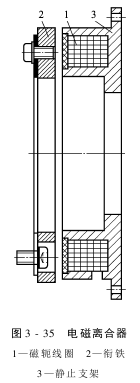() Electromagnetic brake
Electromagnetic brake is a device that uses electromagnetic attraction to pressurize a pair of friction surfaces to generate friction torque to brake. It is composed of stator and static fins and is cooled by air convection. It has only one friction surface, simple structure, good heat dissipation effect, and no viscosity caused by lubricating oil between the friction surfaces, so it responds quickly, moves sensitively, has no idling torque, and can withstand high-frequency stop and start actions, so it is suitable for requirements In situations of rapid response and frequent movements, these characteristics are in line with the needs of loom transmission. But it wears easily, which is the drawback of this form.
Figure 3-35 is a structural example, which is an electromagnetic brake composed of a stationary coil and a braking armature.

The stationary coil embedded with the coil is fixed on the stationary part of the machine through a bracket. The friction plate is embedded in the end face of the rotor, and the armature is installed on the pulley. After the coil is energized, the yoke is excited, forming a magnetic circuit between the yoke coil 1 and the armature 2, thereby attracting the armature and making 2 and the stationary coil close to each other. At this time, a braking friction torque is generated between the two, causing the spindle pulley to quickly stop rotating. When the current is cut off, the armature and friction plate are separated by the restoring force of the spring leaf. Because there is no gap automatic adjustment device, after a period of wear and tear of the gap between the armature and the friction plate, the gap between the static plate and the moving plate will become larger, or if oil stains adhere to it, it will lead to inaccurate parking position. Should be adjusted and cleaned.
The brakes commonly used in water-jet looms have a rated static torque value of 350~500N m, a power consumption of 40~70W, and a power supply of 24V DC.
DC electromagnetic coils are inductive circuits. When the current changes sharply, a back electromotive force will occur in the circuit due to self-induction, preventing the current from changing immediately. This is the transition phenomenon of the DC magnetic circuit. For the electromagnetic brake, there will be a transition time until the armature is sucked after the voltage is applied, which is unfavorable for the fast response required by the loom. In order to shorten the above process and improve sensitivity, some special circuits can be used during the starting or braking stages. For example, during braking, fast excitation circuits, overvoltage excitation circuits or capacitor fast excitation circuits can be used; overvoltage mode is one of them. A commonly used method is that at the initial stage of braking, a high voltage 2 to 3 times the rated voltage is applied to the coil for a short time to shorten the attraction time, make the combined torque rise rapidly, and speed up the braking process; the other method is Reverse braking of the motor accelerates the braking process.
High-speed shuttleless looms also use super starting torque motors to further speed up the starting process to adapt to high speeds. The starting torque of this motor can be 8 to 12 times the normal value.
Due to the adoption of electromagnetic brakes to control the starting and braking of the loom and the application of other electromechanical devices, the operation of the loom can be button-based and easy to operate. Commonly used button types include: start, shut down, emergency shut down, jog, jog one turn, slow reverse, etc. The above are all buttons for controlling the main transmission; in addition, there are some buttons for controlling auxiliary mechanisms, such as weft search. Reverse and forward rotation, electronic warp let-off forward and reverse rotation, electronic take-up forward and reverse rotation, etc.
AAAGFHJTYJUTI
Disclaimer:
Disclaimer: Some of the texts, pictures, audios, and videos of some articles published on this site are from the Internet and do not represent the views of this site. The copyrights belong to the original authors. If you find that the information reproduced on this website infringes upon your rights, please contact us and we will change or delete it as soon as possible.
AA








